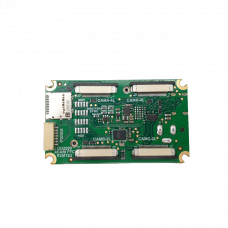OAK-FFC-4P
Overview :
The OAK-FFC-4P (DD2090FFC) baseboard has 4 FFC interfaces which allows for:
Two 2-lane MIPI camera modules, eg. OAK-FFC-OV9282 (stereo pair)
Two 4-lane MIPI camera modules, eg. OAK-FFC-IMX378 RGB camera module, or additional OAK-FFC-OV9282 if RGB camera module is not required. Please note that only revision R1M1E1 and newer camera modules can be connected to this OAK FFC board.To see which cameras are compatible with this OAK FFC baseboard, see the guide here: OAK FFC camera modules. Some of camera modules have a M12 mount, so you can use different lenses to get custom FoV (with wide or narrow FOV M12 lenses).This board uses OAK-SoM-Pro and is also compatible with RPi camera interface. For that you will need a FFC from Arducam, which converts 26-pin Luxonis camera pinout to 22 pin RPi camera pinout.
In addition, IMU (over SPI) sensor is also added to this OAK FFC board.
RVC2 inside : This OAK device is built on top of the RVC2. Main features:
4 TOPS of processing power (1.4 TOPS for AI)
Run any AI model, even custom architectured/built ones - models need to be converted.
Encoding: H.264, H.265, MJPEG - 4K/30FPS, 1080P/60FPS
Computer vision: warp/dewarp, resize, crop via ImageManip node, edge detection, feature tracking. You can also run custom CV functions
Stereo depth perception with filtering, post-processing, RGB-depth alignment, and high configurability
Object tracking: 2D and 3D tracking with ObjectTracker node
Dimensions and Weight :
Width: 62 mm
Height: 38 mm
Length: 22 mm (PCBA and heatsink)
Weight: 41g (PCBA and heatsink)

Key features :
2x 2-Lane MIPI interface
2x 4-Lane MIPI interface
5V power input via barrel jack
USB 3.1 Gen 1 Type-C
Interface for Luxonis OAK-SoM-Pro
Pads for OAK-SoM-Pro 1.8V SPI
Pads for OAK-SoM-Pro 3.3V SDIO
Pads for OAK-SoM-Pro 1.8V Aux Signals (I2C, UART, GPIO)
5V Fan OR USB Type-C
Design files produced with Altium Designer 20
Minimal and maximal perceiving distances of the camera : Minimal depth perceiving distance of the camera depends on mono camera FOV, resolution, baseline and stereo depth mode, more info is available on the Stereo Depth documentation.Since this device has modular mono cameras, you can choose a custom stereo baseline (depending on how it is set up). When using OAK-FFC-OV9282, the formulas for min/max depth perceiving distances are:
Min distance (800P) = 882.5 * baseline / 95
Min distance (400P) = 441.25 * baseline / 95
Min distance with extended disparity (800P) = 882.5 * baseline / 190
Min distance with extended disparity (400P) = max(441.25 * baseline / 190, 19.6)
Max percievable distance (using subpixel) = baseline/2 * tan((90 - 71.9/1280) * PI/180)
For more information about the maximum distance see the Stereo Depth documentation.
 Getting started : The OAK-FFC-4P is powered via USB Type-C or from a 5V, 5.5m x 2.5mm barrel jack, and interfaces to a host via USB 3.1 Gen1 Type-C. With cameras and the OAK-SoM-Pro, total power consumption usually stays below the 900ma specification of USB 3, but Type-C power of 1.5A or greater is recommended. Interfacing with the OAK-SoM-Pro is also possible with OAK-FFC-4P connector pads J3, J4, and J5. These pads are designed for the Amphenol/FCI 20021121-00010T1LF or equivalent. Please refer to the schematics for pinout information.The reset button resets the OAK-SoM-Pro only. The boot button overrides boot mode to USB boot if different boot mode is set on the NOR Flash.The 5V LED indicates 5V power is present on the board. The PG LED indicates “power good” from the OAK-SoM-Pro. The “RUN” LED indicates that the OAK-SoM-Pro is not in reset.
Getting started : The OAK-FFC-4P is powered via USB Type-C or from a 5V, 5.5m x 2.5mm barrel jack, and interfaces to a host via USB 3.1 Gen1 Type-C. With cameras and the OAK-SoM-Pro, total power consumption usually stays below the 900ma specification of USB 3, but Type-C power of 1.5A or greater is recommended. Interfacing with the OAK-SoM-Pro is also possible with OAK-FFC-4P connector pads J3, J4, and J5. These pads are designed for the Amphenol/FCI 20021121-00010T1LF or equivalent. Please refer to the schematics for pinout information.The reset button resets the OAK-SoM-Pro only. The boot button overrides boot mode to USB boot if different boot mode is set on the NOR Flash.The 5V LED indicates 5V power is present on the board. The PG LED indicates “power good” from the OAK-SoM-Pro. The “RUN” LED indicates that the OAK-SoM-Pro is not in reset.
FFC cables : For FFC cables we use Molex series 15166. Along with the OAK FFC board, we ship 26 pin count, same-sided, 152mm cables (part number 151660281). If you would like to use shorter/longer FFC cables, you can get them here.
Enter the code in the box below:





